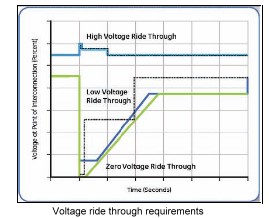
The demand for grid connected
Photo Voltaic (PV) power
systems is growing at a rapid
rate round the world. The growth is
driven by the aggressive targets set by
local governments, higher feed in
tariffs, subsidies provided to PV plant
operators and also by a drop in price of
solar panels thanks to the advent and
popularity of thin film modules.
A critical component of the grid
connected PV power systems is the Grid
connected inverter. The inverter
converts DC power from the panels to
AC power ready to be fed to the grid.
Since PV power is relatively expensive
to conventional sources (~20c/ kwh), it
is critical that power conversion stages
are of high efficiency in order to bring
down the overall cost of solar-power.
Historically residential and small
businesses segment largely drove the
demand. Now larger-scale solar farms
capable of generating tens of megawatts
and feeding into the utility grid are
being commissioned. These farms
mandate novel and robust technology
inverters with higher power rating,
reliability and efficiency ratings.
Typically, inverters that are part of the
grid are in the range of 500 kW.
SOME KEY FUNCTIONALITY OF
UTILITY SCALE INVERTERS
Conversion efficiency: Any solar
inverter should be capable of
maximizing the throughput from the
solar panel. For this it needs to have
Maximum Power Point tracking
(MPPT) over a wide range of solar
voltages. Also the conversion
efficiency for the utility scale
inverters need to be high, CEC
(California Energy Commission)
weighted efficiency greater than 96
per cent is essential.

Grid interaction features: Gridconnected
inverters should be capable
of meeting the various country specific
grid code requirements. Voltage ride
through capability is a vital feature in
grid connected converter that helps
them stay connected to the grid even
in the event of voltage disturbances.
GE's 600 kW solar inverter offers Low
voltage, Zero voltage and High voltage
ride through functionalities (LVRT,
ZVRT and HVRT).
Additional care has to be taken to
ensure that the Inverters do not feed
into a section of a network (island)
that has been disconnected either
intentionally by the grid operator or
due to faults. This is important for
the safety of any maintenance crew
that may be working on the line.
Also in case the Solar inverter
continues operate, it could also
violate the voltage and frequency
specifications of the system and lead
to damage of connected utility and
customer equipment. Advance antiislanding
algorithms that detect the
formation of islands and trip the
inverter are an essential feature for
grid connected inverters.
Using the inverters, it is also
possible to provide reactive power
support to the grid, especially during
times when solar production is not
active. This can help improve the
voltage stability and result in a more
optimally functioning grid
PLANT LEVEL CONTROLS
A solar farm consists of multiple solar
inverters connected to an array of PV
panels. Coordinated control of multiple
inverters as well as data acquisition and
visualization for the entire plant can
enable the solar plant mimic the of a
conventional power generation plant.
The plant level control would provide
all the standard power plant like
controls like Over frequency droop,
Power ramp rate controls, start up /shut
down of plant, power curtailment and
power factor/voltage control
One of the main challenges faced by
renewable-based power generating
systems is the intermittent and
unpredictable nature of power
output. With advances in modern
energy storage technologies,
interfacing inverters with energy
storage technologies is an active area
of interest. In addition to maintain a
steady power output, an energy
storage coupled inverter can also be
used for frequency regulation
applications if needed in frequency
regulation markets. An additional area
of interest would be in the field of
modular power conversion systems
that help reduce the installation time
and costs for the end customer.
With the growing demand for grid
connected PV systems, issues
regarding the impact of high
penetration of solar power into grid
need to be studied in detail. Also
emerging and changing requirements
of grid codes of various countries can
present significant challenges to the
design of grid-connected inverters.
(Pradeep V has a ME degree in
electrical engineering from Indian
Institute of Science, Bangalore, and is
with GE Global Research Centre,
Bangalore since March 2001.)